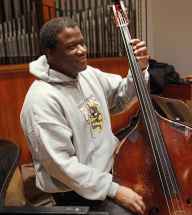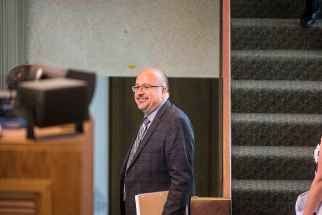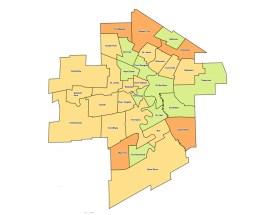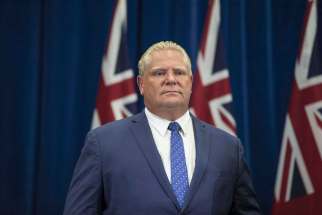Proposed provincial electoral boundary changes draw fire
Read this article for free:
or
Already have an account? Log in here »
To continue reading, please subscribe:
Monthly Digital Subscription
$0 for the first 4 weeks*
- Enjoy unlimited reading on winnipegfreepress.com
- Read the E-Edition, our digital replica newspaper
- Access News Break, our award-winning app
- Play interactive puzzles
*No charge for 4 weeks then price increases to the regular rate of $19.00 plus GST every four weeks. Offer available to new and qualified returning subscribers only. Cancel any time.
Monthly Digital Subscription
$4.75/week*
- Enjoy unlimited reading on winnipegfreepress.com
- Read the E-Edition, our digital replica newspaper
- Access News Break, our award-winning app
- Play interactive puzzles
*Billed as $19 plus GST every four weeks. Cancel any time.
To continue reading, please subscribe:
Add Free Press access to your Brandon Sun subscription for only an additional
$1 for the first 4 weeks*
*Your next subscription payment will increase by $1.00 and you will be charged $16.99 plus GST for four weeks. After four weeks, your payment will increase to $23.99 plus GST every four weeks.
Read unlimited articles for free today:
or
Already have an account? Log in here »
Hey there, time traveller!
This article was published 10/09/2018 (2647 days ago), so information in it may no longer be current.
A Conservative member of Parliament says it would be “premature” for Winnipeg to gain a seat in the legislature at the expense of rural Manitoba.

James Bezan told the Manitoba Electoral Divisions Boundaries Commission he is “very concerned” about the commission’s proposal to boost city representation to 32 constituencies (from 31), leaving the rest of the province with 25.
“I think we’re being premature to add that seat to Winnipeg right now,” he told the five-member panel, chaired by Manitoba Chief Justice Richard Chartier.
Doing so “may exacerbate the alienation that rural Manitobans feel within the province right now.”
Commission guidelines
The province’s electoral boundaries are reviewed every 10 years. The commission’s final report, due at the end of the year, will draw the electoral map for the 2020 provincial election. Here are the guidelines it uses to rejig the map.
The province’s electoral boundaries are reviewed every 10 years. The commission’s final report, due at the end of the year, will draw the electoral map for the 2020 provincial election.
The commission’s guidelines include:
• To the extent that it does not detract from effective representation, the population of each electoral division will fall within a variance of plus or minus five per cent of 22,427 (Manitoba’s census population divided by 57 — the number of constituencies).
• When considering the population variances of electoral divisions, informed population growth projections will be taken into account.
• To the extent possible, electoral divisions will respect the territorial integrity of municipalities, Indigenous communities and designated bilingual areas.
• To the extent possible, rivers, lakes, railways, parks and major highways will be used as boundaries.
— source: Manitoba Electoral Divisions Boundaries Commission
Based strictly upon 2016 census data, Winnipeg is entitled to 31.45 seats and rural Manitoba 25.6 seats, Bezan said, in making the case for maintaining the status quo.
The commission, which began provincewide hearings Monday in Winnipeg, is proposing to boost the city’s complement based on population trends.
The province’s electoral boundaries are reviewed every 10 years. The commission’s final report, due at the end of the year, will draw the electoral map for the 2020 provincial election.
Bezan noted, according to provincial law, seat distribution is based on actual population, not projected. But Chartier said the commission is also guided by a unanimous ruling by the Supreme Court of Canada the establishment of electoral boundaries take into account population projections.
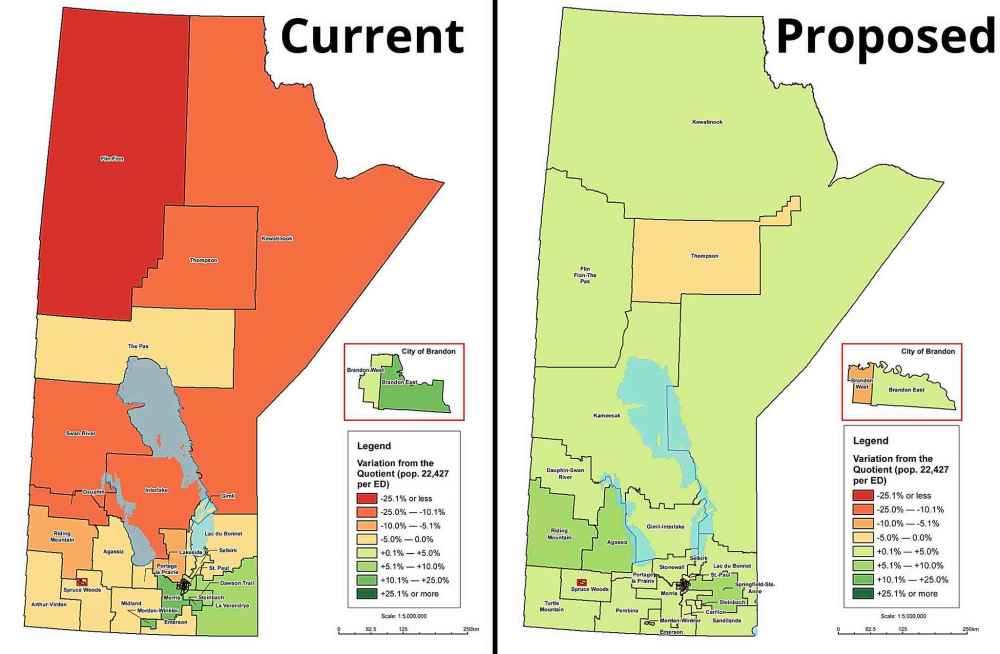
The commission’s mandate is to divide up Manitoba’s 57 electoral districts as evenly as it can, while taking into account such factors as physical and municipal boundaries, Indigenous communities and designated bilingual areas.
The commission produced an interim report in May, after receiving nearly 50 written submissions. It is visiting close to a dozen Manitoba communities in the next 10 days, concluding its hearings in Winnipeg on the evening of Sept. 20.

Based on 2016 census data, the commission has established a “quotient” of 22,427 people for each constituency. Its proposed electoral map would consist of electoral districts with populations of plus-or-minus-five per cent of that figure.
Bezan noted 22 of the 32 city seats under the commission’s proposal would be “below quotient,” while only four of the 25 constituencies outside Winnipeg would have fewer than 22,427 people.
“So, I would say you have prematurely diminished the voices of rural Manitobans in the Manitoba legislature,” the MP said.
Bezan was one of only five presenters at the morning hearing Monday.
Assiniboia independent MLA Steven Fletcher argued against a proposal that would result in the constituency of Charleswood absorbing a small piece of St. James.“The city draws its boundaries about as well as it does its budget… And both are terrible.” – Steven Fletcher
He said Charleswood constituency’s boundaries ought not to extend north of the Assiniboine River. “It is inconsistent with your guidelines. It’s inconsistent with the community. It is inconsistent with expectations,” he told the commissioners.
Fletcher proposed Charleswood’s boundaries be pushed eastward to Shaftesbury Boulevard instead.
When Chartier noted the commission’s proposal was identical to one being adopted by the City of Winnipeg, Fletcher shot back: “Well, the city draws its boundaries about as well as it does its budget… And both are terrible.”

Activist and educator Blandine Tona lamented the commission was using 20-year-old statistics in its attempts to accommodate francophone communities.
She urged the commission to conduct an analysis of 2016 census data to ensure geographic shifts involving Manitoba’s more than 100,000 French-speakers are accounted for as much as possible.
Chartier said the commission’s proposed boundary changes respects traditional francophone communities and has adjusted boundaries in southeast Winnipeg accordingly.
“It’s outside the mandate of our commission to start creating… bilingual zones or finding out where the (francophone) population might be today,” he told Tona, who ran unsuccessfully for the NDP in this summer’s St. Boniface byelection.
In addition to Chartier, the commissioners include: University of Manitoba president David Barnard, Brandon University interim president Steven Robinson, University College of the North dean, faculty of arts, business and science Harvey Briggs, and Shipra Verma, Manitoba’s chief electoral officer.
larry.kusch@freepress.mb.ca

Our newsroom depends on a growing audience of readers to power our journalism. If you are not a paid reader, please consider becoming a subscriber.
Our newsroom depends on its audience of readers to power our journalism. Thank you for your support.

